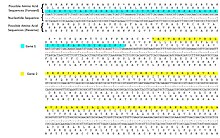
A·GGT·GAC·ACC·GCA·AGC·CTT·ATA·TTA·GC
AG·GTG·ACA·CCG·CAA·GCC·TTA·TAT·TAG·C
In molecular biology, a reading frame is a way of dividing the sequence of nucleotides in a nucleic acid (DNA or RNA) molecule into a set of consecutive, non-overlapping triplets. Where these triplets equate to amino acids or stop signals during translation, they are called codons.
A single strand of a nucleic acid molecule has a phosphoryl end, called the 5′-end, and a hydroxyl or 3′-end. These define the 5′→3′ direction. There are three reading frames that can be read in this 5′→3′ direction, each beginning from a different nucleotide in a triplet. In a double stranded nucleic acid, an additional three reading frames may be read from the other, complementary strand in the 5′→3′ direction along this strand. As the two strands of a double-stranded nucleic acid molecule are antiparallel, the 5′→3′ direction on the second strand corresponds to the 3′→5′ direction along the first strand.[1][2]
In general, at the most, one reading frame in a given section of a nucleic acid, is biologically relevant (open reading frame). Some viral transcripts can be translated using multiple, overlapping reading frames. There is one known example of overlapping reading frames in mammalian mitochondrial DNA: coding portions of genes for 2 subunits of ATPase overlap.

- ^ Rainey S, Repka J. "Quantitative sequence and open reading frame analysis based on codon bias" (PDF). Systemics, Cybernetics and Informatics. 4 (1): 65–72.
- ^ Badger JH, Olsen GJ (April 1999). "CRITICA: Coding Region Identification Tool Invoking Comparative Analysis". Mol Biol Evol. 16 (4): 512–24. doi:10.1093/oxfordjournals.molbev.a026133. PMID 10331277.